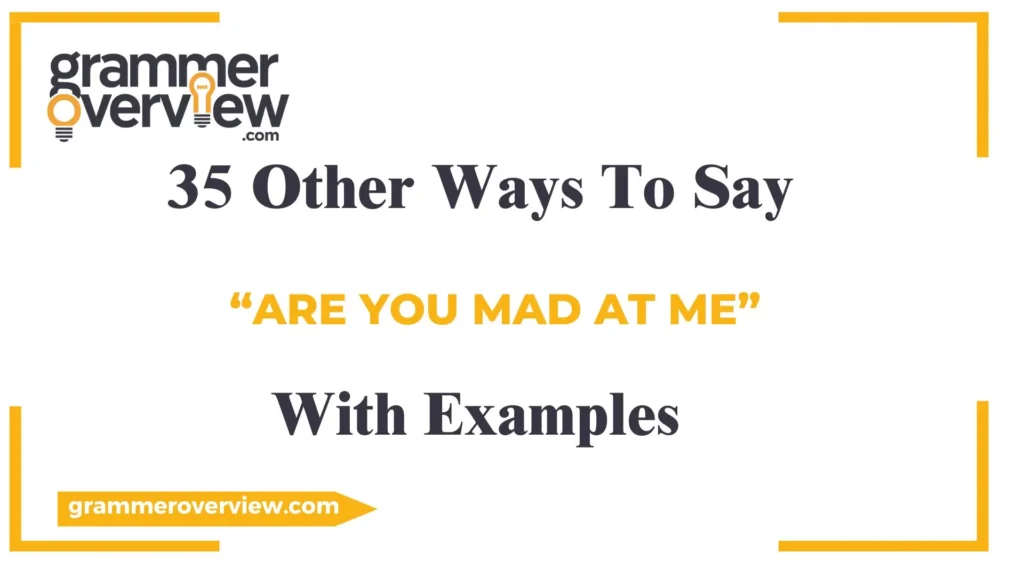Here are 35 different ways to ask “Are you mad at me?” that sounds more thoughtful, caring, and empathetic.
Sometimes, when emotions are running high, finding the right words to ask if someone is upset with you can be difficult. Phrasing your question carefully can help diffuse tension and show concern and respect for the other person’s feelings.
What Does “Are You Mad at Me?” Mean?
The phrase “Are you mad at me?” is often used when someone senses tension or a change in behavior in a relationship and is seeking reassurance. It’s a direct and simple way to ask if the person is angry or upset with you. However, depending on the context and tone, it can feel blunt or even confrontational. By using different expressions, you can ask the same question with more sensitivity, ensuring the other person feels heard and respected.
When to Use “Are You Mad at Me?”
Use the question “Are you mad at me?” when you feel there might be tension or distance between you and someone close to you. It’s important to be aware of the other person’s mood, and if you’re noticing signs of frustration, confusion, or withdrawal, it’s natural to want to check in with them. This direct question, however, can sometimes make things worse if it’s asked in an accusatory or defensive way, so consider using alternative phrases to soften the approach.
Is It Professional/Polite to Say “Are You Mad at Me?”
While “Are you mad at me?” is generally polite, it can feel a little too blunt or awkward in professional settings. It’s always important to be mindful of the context, especially when you’re addressing colleagues, bosses, or clients. Opting for a more neutral or thoughtful phrase can help you avoid unnecessary tension, and you may want to be careful if you’re unsure of the other person’s feelings. In professional settings, diplomacy is key.
Pros and Cons of Asking “Are You Mad at Me?”
Pros:
- It directly addresses the issue.
- Shows vulnerability and concern.
- Can open up a conversation to clear the air.
Cons:
- Can feel confrontational or defensive.
- Might make the person feel pressured to respond a certain way.
- May make the situation feel more uncomfortable than it already is.
Are You Mad at Me Synonyms:
- “Are You Upset with Me?”
- “Did I Do Something to Offend You?”
- “Is Everything Okay Between Us?”
- “Are You Feeling Alright?”
- “I Feel Like Something’s Off Did I Do Something Wrong?”
- “Did I Say Something to Upset You?”
- “You Seem Quiet Is Everything Okay?”
- “Are We Good?”
- “I’ve Noticed a Change in Your Mood Is Something on Your Mind?”
- “Is Something Going On That’s Bothering You?”
- “Did I Do Something to Hurt You?”
- “Have I Done Something to Upset You?”
- “You’ve Been Quiet Did I Say Something Wrong?”
- “Are You Upset with Me for Something?”
- “I Can Tell Something’s Not Right Can We Talk?”
- “I Don’t Want to Assume Anything, But Are You Upset with Me?”
- “You Haven’t Been Yourself Lately Is Everything Okay?”
- “Is There Something We Need to Address?”
- “Is There Anything I Did That Made You Upset?”
- “Are We on the Same Page?”
- “Is There Something You’re Holding Back?”
- “I Can Sense Some Tension Would You Like to Talk About It?”
- “Are You Upset with Me for Something I Didn’t Realize?”
- “You Haven’t Responded to Me Did I Do Something to Offend You?”
- “Is There Something You’d Like to Say?”
- “I’ve Noticed Some Distance Is Everything Okay?”
- “Have I Done Something to Hurt You?”
- “You Seem Off What’s Going On?”
- “Did I Say Something That Doesn’t Sit Right With You?”
- “Is There Tension Between Us?”
- “I’m Noticing You’re Acting Differently Anything on Your Mind?”
- “Are We Good? I Feel Like There’s Something We Need to Address.”
- “Are You Feeling Okay? You Seem a Little Off.”
- “It Feels Like There’s Some Distance Between Us. Can We Talk?”
- “Is There Something I Should Know About?”
“Are You Upset with Me?”
Meaning:
A softer way of asking if someone is angry.
Explanation:
This phrase feels less direct than “Are you mad at me?” and can create a more open environment for dialogue.
Example:
“Are you upset with me about what happened earlier?”
Best Use:
In situations where you want to gently acknowledge possible tension.
Worst Use:
When you’re unsure if the person is upset.
Tone:
Empathetic, thoughtful.
“Did I Do Something to Offend You?”
Meaning:
A way to express concern over possibly having hurt someone’s feelings.
Explanation:
This phrasing takes the focus off the person’s emotions and onto the action that may have caused hurt.
Example:
“Did I do something to offend you? I didn’t mean to upset you.”
Best Use:
When you’re unsure if your actions were the cause of tension.
Worst Use:
When you’re certain the issue is something emotional, not just an action.
Tone:
Careful, and considerate.
“Is Everything Okay Between Us?”
Meaning:
A broader and more gentle inquiry about the relationship’s status.
Explanation:
This expression is less focused on blame and more on the overall dynamic.
Example:
“I’ve noticed you seem a bit distant. Is everything okay between us?”
Best Use:
When you want to check in without implying that the person is angry.
Worst Use:
When the situation is tense and needs more direct addressing.
Tone:
Calm, open.
“Are You Feeling Alright?”
Meaning:
A caring question that shifts the focus from potential anger to the person’s well-being.
Explanation:
This shows concern for the person’s emotional state in a way that is less accusatory.
Example:
“You’ve been quiet lately. Are you feeling alright?”
Best Use:
When the person seems withdrawn or upset, you want to express concern for their emotional state.
Worst Use:
If you already know the person is upset but want to avoid directly addressing it.
Tone:
Compassionate, concerned.
“I Feel Like Something’s Off Did I Do Something Wrong?”
Meaning:
A self-reflective way of asking if something you did caused the tension.
Explanation:
This question shows vulnerability and allows the other person to express their feelings without feeling defensive.
Example:
“I feel like something’s off. Did I do something wrong?”
Best Use:
When you’re uncertain about the cause of the tension and want to take responsibility if needed.
Worst Use:
When the issue isn’t related to something you did.
Tone:
Vulnerable, open.
“Did I Say Something to Upset You?”
Meaning:
A direct but considerate way of inquiring if something you said caused distress.
Explanation:
It focuses specifically on words or actions, without making assumptions.
Example:
“I’m sorry if I said something to upset you. Can we talk about it?”
Best Use:
When you suspect your words may have been the cause of hurt.
Worst Use:
When the issue is unrelated to your actions or words.
Tone:
Apologetic, understanding.
“You Seem Quiet Is Everything Okay?”
Meaning:
A gentle, observational way to ask if there’s an issue.
Explanation:
This expression focuses more on the other person’s behavior and invites them to open up without being accusatory.
Example:
“You’ve been quiet today. Is everything okay?”
Best Use:
When someone is withdrawn, and you want to check in without being too direct.
Worst Use:
When there’s no noticeable change in behavior, the person might not feel anything is wrong.
Tone:
Gentle, caring.
“Are We Good?”
Meaning:
A casual, non-confrontational way to ask if there’s any lingering tension.
Explanation:
This phrase is informal and suggests a lighter tone, suitable for close friends or acquaintances.
Example:
“Hey, are we good? You seem a bit off.”
Best Use:
In casual relationships or friendships when you want to check in without being too serious.
Worst Use:
In formal or professional relationships, as it may sound too laid-back.
Tone:
Casual, laid-back.
“I’ve Noticed a Change in Your Mood Is Something on Your Mind?”
Meaning:
A thoughtful way to ask if there’s an underlying issue affecting the person’s mood.
Explanation:
This phrase acknowledges the emotional shift without making assumptions or accusations.
Example:
“I’ve noticed a change in your mood Is something on your mind?”
Best Use:
When you notice a change in behavior and want to offer an opportunity for the person to share their feelings.
Worst Use:
If the person doesn’t want to talk or is dealing with personal issues.
Tone:
Empathetic, and understanding.
“Is Something Going On That’s Bothering You?”
Meaning:
A direct yet caring inquiry into whether something is troubling the other person.
Explanation:
This phrasing opens the door for the other person to share their feelings without assuming anger.
Example:
“I noticed you’ve been distant lately. Is something going on that’s bothering you?”
Best Use:
When you’re genuinely concerned about the person’s emotional state.
Worst Use:
When the issue is unrelated to emotional distress.
Tone:
Supportive, concerned.
“Did I Do Something to Hurt You?”
Meaning:
A direct, reflective question that asks if you’ve unintentionally hurt the person.
Explanation:
This phrasing invites the other person to express any hurt feelings while taking responsibility if needed.
Example:
“Did I do something to hurt you? I didn’t mean to upset you.”
Best Use:
When you believe your actions may have caused hurt.
Worst Use:
When the person is not upset because of your actions.
Tone:
Apologetic, self-reflective.
“Have I Done Something to Upset You?”
Meaning:
A reflective inquiry that asks if your actions have caused distress.
Explanation:
This approach puts the focus on the actions rather than assuming the person is angry, showing your willingness to understand what went wrong.
Example:
“I’ve been thinking about our conversation. Have I done something to upset you?”
Best Use:
When you want to take responsibility and understand the specific issue.
Worst Use:
If you haven’t done anything wrong, and the person is upset for other reasons.
Tone:
Apologetic, thoughtful.
“You’ve Been Quiet Did I Say Something Wrong?”
Meaning:
A gentle way of asking if something you said caused discomfort.
Explanation:
This expression acknowledges the person’s behavior (quietness) and invites them to express if anything was off in their communication.
Example:
“You’ve been quiet today. Did I say something wrong?”
Best Use:
When the person is showing signs of being upset but you’re unsure why.
Worst Use:
If the person is simply introverted or not upset at all.
Tone:
Light, concerned.
“Are You Upset with Me for Something?”
Meaning:
A slightly more direct variation that asks if the person is upset due to an action or situation.
Explanation:
This phrasing leaves room for the person to clarify what specifically might be causing the upset feeling.
Example:
“Are you upset with me for something I did yesterday?”
Best Use:
When you have a specific incident in mind and want clarity.
Worst Use:
If the cause of the upset is unclear and might not be related to your actions.
Tone:
Direct, probing.
“I Can Tell Something’s Not Right Can We Talk?”
Meaning:
A more open-ended way to invite a conversation when you sense something is off.
Explanation:
This is less about asking if the person is mad and more about creating space for dialogue.
Example:
“I can tell something’s not right. Can we talk about it?”
Best Use:
When you sense tension but want to approach the conversation without directly asking about anger.
Worst Use:
When the person is not ready to talk yet.
Tone:
Caring, inviting.
“I Don’t Want to Assume Anything, But Are You Upset with Me?”
Meaning:
A thoughtful and cautious way to ask if there’s an issue without assuming the other person’s feelings.
Explanation:
This phrasing allows the person to share their feelings openly without feeling judged or cornered.
Example:
“I don’t want to assume anything, but are you upset with me?”
Best Use:
When you want to be sensitive and not impose your thoughts on the person.
Worst Use:
If the situation is more serious and requires a more direct approach.
Tone:
Sensitive, respectful.
“You Haven’t Been Yourself Lately Is Everything Okay?”
Meaning:
An empathetic inquiry that suggests you’ve noticed a change in behavior and care about the person’s well-being.
Explanation:
This approach focuses on the change in behavior rather than directly addressing anger, which can feel less confrontational.
Example:
“You haven’t been yourself lately Is everything okay?”
Best Use:
When the person seems different but you’re not sure why.
Worst Use:
When the person may not be ready to open up.
Tone:
Compassionate, understanding.
“Is There Something We Need to Address?”
Meaning:
A neutral and open-ended way to ask if there’s a problem to discuss.
Explanation:
This phrasing avoids the assumption that the issue is anger and opens the floor for more honest communication.
Example:
“I feel like there might be something we need to address. Can we talk?”
Best Use:
When you’re unsure if the person is angry or if there’s a deeper issue.
Worst Use:
When the issue is already apparent and you need a more direct approach.
Tone:
Neutral, calm.
“Is There Anything I Did That Made You Upset?”
Meaning:
A direct, but sensitive inquiry into whether your actions caused the upset feelings.
Explanation:
This approach asks for clarity while showing a willingness to take responsibility.
Example:
“I’m sorry if I did something that made you upset. Can you help me understand what happened?”
Best Use:
When you suspect your actions were the source of the problem.
Worst Use:
If you have no reason to believe you did anything wrong.
Tone:
Apologetic, open.
“Are We on the Same Page?”
Meaning:
A non-accusatory way of checking in on the relationship and understanding if there’s an issue.
Explanation:
This phrase doesn’t directly ask if the person is angry but focuses on alignment and understanding between the two of you.
Example:
“I want to make sure we’re on the same page. Is everything okay?”
Best Use:
When you want to ensure you both understand each other and there are no misunderstandings.
Worst Use:
When the situation is more emotional, you need to address feelings directly.
Tone:
Collaborative, neutral.
“Is There Something You’re Holding Back?”
Meaning:
A more probing question that invites the person to share if they’re keeping something to themselves.
Explanation:
This phrasing opens the door for the person to share their feelings, particularly if they’ve been holding something in.
Example:
“You seem quiet Is there something you’re holding back?”
Best Use:
When you suspect there’s something the person isn’t saying and want to give them the chance to open up.
Worst Use:
If the person is not ready to talk or share.
Tone:
Gentle, inquisitive.
“I Can Sense Some Tension Would You Like to Talk About It?”
Meaning:
An empathetic way of acknowledging the tension and offering to address it.
Explanation:
This question expresses awareness of the situation while giving the other person the choice to engage in a conversation.
Example:
“I can sense some tension between us. Would you like to talk about it?”
Best Use:
When you feel a shift in the dynamic and want to create space for dialogue.
Worst Use:
If the tension is minor or if the other person is not ready to talk.
Tone:
Compassionate, respectful.
“Are You Upset with Me for Something I Didn’t Realize?”
Meaning:
A reflective question that focuses on unintentional actions or words.
Explanation:
This phrasing suggests that you might not have realized something you did or said could cause upset, but you’re willing to listen and understand.
Example:
“Are you upset with me for something I didn’t realize? I want to make sure we’re good.”
Best Use:
When you suspect your actions may have caused tension but weren’t aware of it.
Worst Use:
If the person’s upset isn’t related to anything you did.
Tone:
Apologetic, self-reflective.
“You Haven’t Responded to Me Did I Do Something to Offend You?”
Meaning:
A more specific approach is to ask if silence is due to something you did or said.
Explanation:
This phrasing directly addresses the silence or lack of communication, questioning if your actions are the cause.
Example:
“You haven’t responded to my messages Did I do something to offend you?”
Best Use:
When you notice a lack of response or communication and suspect it’s due to a misunderstanding.
Worst Use:
If the person might be busy or unable to respond for other reasons.
Tone:
Direct, concerned.
“Is There Something You’d Like to Say?”
Meaning:
A broad, open-ended question that invites the person to share whatever might be on their mind.
Explanation:
This phrase invites the other person to express their feelings in their own time, without making assumptions about their emotional state.
Example:
“I can tell something’s bothering you. Is there something you’d like to say?”
Best Use:
When the person seems withdrawn, you want to open the door for honest communication.
Worst Use:
If the person is not ready to talk.
Tone:
Respectful, open.
“I’ve Noticed Some Distance Is Everything Okay?”
Meaning:
A non-confrontational way to address a perceived emotional gap or coldness.
Explanation:
This phrase brings attention to the emotional distance or shift in behavior, offering a chance for the person to open up about their feelings without feeling attacked.
Example:
“Lately, I’ve noticed some distance between us. Is everything okay?”
Best Use:
When someone seems emotionally distant or distant for no clear reason.
Worst Use:
If the person has been busy or preoccupied and the distance isn’t about a conflict.
Tone:
Thoughtful, concerned.
“Have I Done Something to Hurt You?”
Meaning:
A direct and vulnerable inquiry asking if your actions have caused harm.
Explanation:
This question conveys that you are open to hearing if you’ve hurt the person, signaling empathy and a willingness to address any issues.
Example:
“I’m so sorry if I’ve said something that hurt you. Have I done something to hurt you?”
Best Use:
When you are genuinely concerned that you’ve caused emotional pain and want to make it right.
Worst Use: If there is no reason to believe you’ve hurt them it could create unnecessary pressure.
Tone:
Sincere, apologetic.
“You Seem Off What’s Going On?”
Meaning:
A casual way of asking if something is wrong or bothering the person.
Explanation:
This approach is less formal and can be useful when you want to keep the conversation light but still acknowledge that something is off.
Example:
“You seem off today. What’s going on?”
Best Use:
When the person seems to be acting out of the ordinary, and you want to check-in.
Worst Use:
If the person is going through something personal and isn’t ready to discuss it.
Tone:
Casual, concerned.
“Did I Say Something That Doesn’t Sit Right With You?”
Meaning:
A direct inquiry into whether something you said caused discomfort or offense.
Explanation:
This phrase gets straight to the point, asking if your words caused a negative reaction without assuming or accusing you.
Example:
“I’ve been thinking about our conversation. Did I say something that doesn’t sit right with you?”
Best Use:
When you want to clarify if something you said might have upset the person.
Worst Use:
If you don’t have any specific reason to believe you said something wrong.
Tone:
Honest, open.
“Is There Tension Between Us?”
Meaning:
A direct and clear way to ask if there’s a hidden conflict.
Explanation:
This is an upfront question that seeks clarity about any potential tension or issues without dancing around the topic.
Example:
“I’ve been feeling some tension between us lately. Is everything okay?”
Best Use:
When there is a noticeable shift in behavior or emotional climate.
Worst Use:
If the tension isn’t there or if it’s caused by something unrelated to you.
Tone:
Direct, curious.
“I’m Noticing You’re Acting Differently Anything on Your Mind?”
Meaning:
A more gentle way of asking if the person is upset is by acknowledging a change in their behavior.
Explanation:
This question focuses on behavior and invites the person to share what’s going on without assuming anger.
Example:
“I’m noticing you’re acting differently lately. Is there anything on your mind?”
Best Use:
When the person seems like they’re holding something back and you’re looking to help.
Worst Use:
When the person may not be ready to discuss their emotions.
Tone:
Soft, concerned.
“Are We Good? I Feel Like There’s Something We Need to Address.”
Meaning:
A casual but honest way to check in on your relationship and gauge if there’s a need for a conversation.
Explanation:
This question gives the person the opportunity to share if something is bothering them without forcing the issue.
Example:
“Are we good? I feel like there’s something we need to address.”
Best Use:
When you feel like something might be amiss but want to keep the tone light.
Worst Use:
If the issue is serious and requires a more sensitive or private approach.
Tone:
Light, straightforward.
“Are You Feeling Okay? You Seem a Little Off.”
Meaning:
A gentle inquiry into the person’s emotional state, focusing on their well-being.
Explanation:
This approach is more about checking on the person’s general emotional state rather than assuming they’re angry or upset.
Example:
“You seem a little off today. Are you feeling okay?”
Best Use:
When you notice changes in mood or behavior and want to offer support.
Worst Use:
If the person isn’t feeling off, or if they may not want to talk about it yet.
Tone:
Caring, gentle.
“It Feels Like There’s Some Distance Between Us. Can We Talk?”
Meaning:
An invitation to discuss the emotional or relational gap between you, rather than focusing on anger specifically.
Explanation:
This phrasing creates a neutral space for a more open discussion about what might be causing emotional distance.
Example:
“I’ve been feeling like there’s some distance between us. Can we talk about it?”
Best Use:
When you sense emotional distance but don’t want to assume the cause.
Worst Use:
If the distance is due to external factors and not because of a conflict.
Tone:
Open, inviting.
“Is There Something I Should Know About?”
Meaning:
A subtle yet open question inviting the person to share what’s on their mind.
Explanation:
This phrasing is a little more indirect, suggesting you’re open to hearing whatever they feel is important to address without directly assuming they’re mad.
Example:
“Is there something I should know about? It seems like something’s bothering you.”
Best Use:
When you sense something is off but you don’t want to put pressure on the other person.
Worst Use:
If you need to address a specific issue more directly.
Tone:
Neutral, inviting.
Conclusion
Whether you’re dealing with a friend, family member, or colleague, the right phrasing can make all the difference in creating an open and supportive dialogue. Keep these alternatives in mind, and remember that asking questions with care will always invite honest conversations and strengthen relationships. In moments of uncertainty about someone’s emotions, it’s important to approach the conversation with empathy, sensitivity, and respect.
By using any of the 35 alternative ways to ask “Are you mad at me?”, you can express your concern, provide an opening for communication, and deepen your understanding of each other’s feelings.




